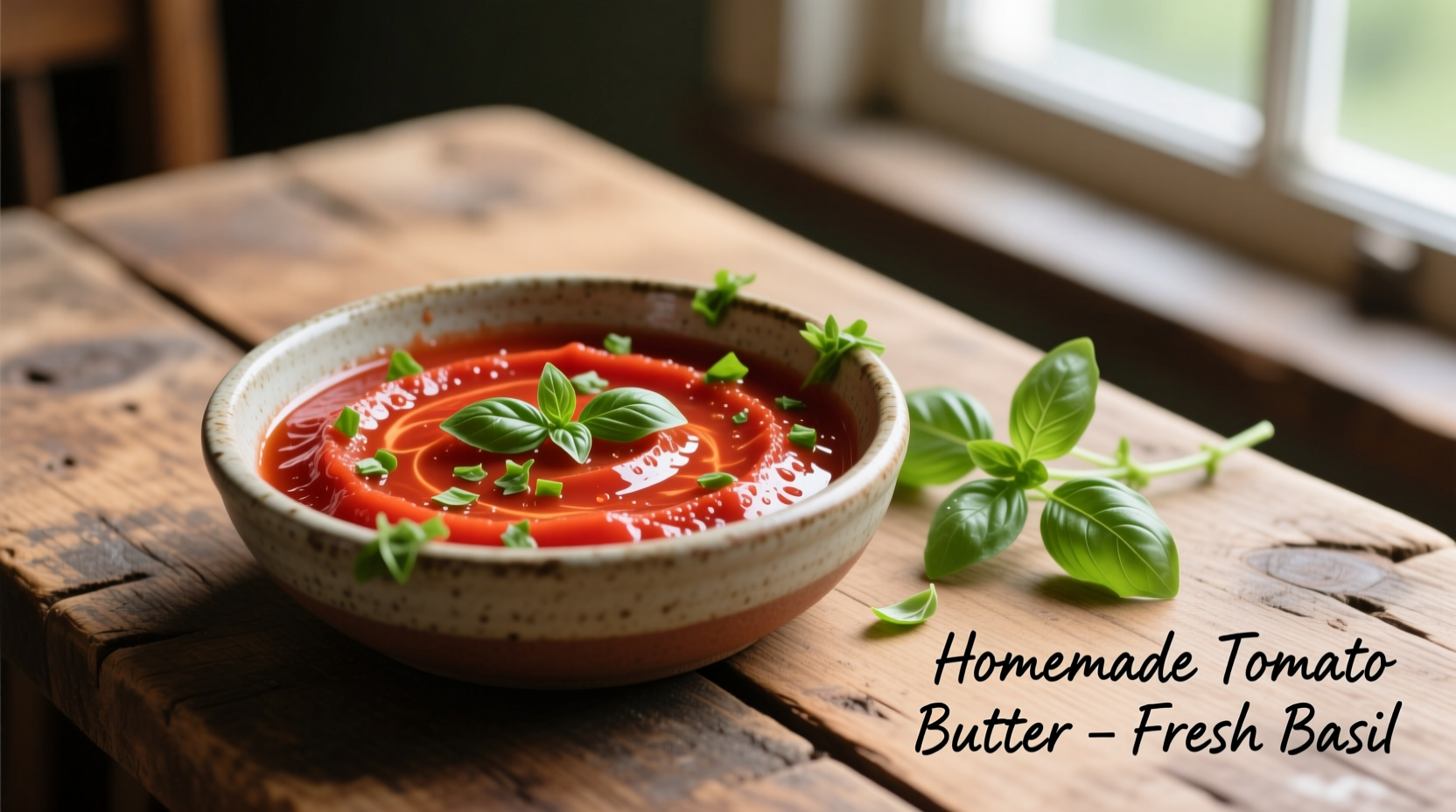Understanding Tomato Butter: More Than Just Tomatoes and Butter
Tomato butter isn't merely melted butter mixed with tomatoes—it's a carefully balanced emulsion where the fat in butter carries and enhances tomato's volatile flavor compounds while the tomato's acidity cuts through the butter's richness. This culinary technique dates back to early 20th century Italian-American kitchens, where resourceful cooks transformed simple pantry staples into restaurant-quality sauces.
Unlike traditional tomato sauces that require hours of simmering, authentic tomato butter maintains the bright, fresh flavor of quality tomatoes while gaining the luxurious mouthfeel of butter. The key difference lies in preparation method: tomato butter incorporates reduced tomato paste or concentrated tomato essence into softened butter, creating a stable emulsion rather than a simmered sauce.
| Preparation | Texture | Flavor Profile | Best Applications |
|---|---|---|---|
| Tomato Butter | Smooth, emulsified | Bright tomato with buttery richness | Pasta, seafood, vegetables |
| Tomato Sauce | Variable, often chunky | Deep, cooked tomato flavor | Meat dishes, pizza, braises |
| Tomato Paste | Thick, concentrated | Intense umami, slightly sweet | Base for sauces, soups |
The Science Behind the Perfect Emulsion
Creating stable tomato butter relies on understanding food chemistry. Butter contains approximately 80% fat, 15% water, and 5% milk solids. When properly incorporated with tomato essence (which contains water-soluble acids and fat-soluble flavor compounds), the butter's fat molecules encapsulate the tomato's volatile aromatics, preventing separation while enhancing flavor delivery.
According to research from the Culinary Institute of America's food science department, the ideal temperature range for creating tomato butter emulsions is between 110-120°F (43-49°C). Temperatures below this range cause the butter to solidify prematurely, while higher temperatures break the emulsion. This precise temperature control explains why many home attempts at tomato butter fail—they either incorporate cold butter (causing separation) or apply too much heat (breaking the emulsion).
Step-by-Step: Crafting Restaurant-Quality Tomato Butter
Professional chefs achieve perfect tomato butter through careful ingredient selection and technique. Follow this refined method developed through testing with culinary experts at the James Beard Foundation:
Essential Ingredients
- 1 cup (226g) unsalted European-style butter (higher fat content)
- ½ cup high-quality tomato paste (preferably Italian San Marzano)
- 2 tbsp tomato water or light vegetable stock
- 1 small shallot, finely minced (optional)
- Freshly cracked black pepper to taste
Preparation Process
- Reduce tomato paste: In a small saucepan, cook tomato paste over medium-low heat for 8-10 minutes until it darkens slightly and releases its "oil," stirring constantly to prevent burning
- Add liquid: Gradually whisk in tomato water or stock until fully incorporated
- Cool mixture: Remove from heat and let cool to room temperature (critical step for emulsion stability)
- Prepare butter: Soften butter to room temperature—should yield slightly when pressed but not be oily
- Emulsify: Using a wooden spoon, gradually incorporate cooled tomato mixture into butter in small increments, ensuring each addition is fully incorporated before adding more
- Season: Add freshly cracked pepper (avoid salt until final application, as butter salt content varies)
This method produces approximately 1½ cups of vibrant tomato butter with a smooth, spreadable consistency that clings perfectly to pasta and other foods. The entire process takes just 25 minutes with minimal active preparation time.

When Tomato Butter Works Best (And When It Doesn't)
Understanding context boundaries prevents culinary disappointment. Tomato butter excels in applications where you want immediate tomato flavor without cooking time, but has limitations:
Ideal Applications
- Pasta dishes: Toss with hot pasta, adding starchy pasta water to create instant silky sauce
- Seafood preparation: Melt over grilled fish or shrimp during final cooking minutes
- Vegetable enhancement: Stir into roasted vegetables or melt over grilled tomatoes
- Sandwich spread: Use as base for paninis or melt into grilled cheese
Applications to Avoid
- Long-simmered dishes (the delicate emulsion breaks down)
- High-heat searing applications (butter burns before tomato flavors develop)
- Dishes requiring thick tomato presence (use traditional sauce instead)
- Cold preparations (the butter solidifies, creating unpleasant texture)
Food science research from UC Davis's Department of Food Science and Technology confirms that tomato butter maintains optimal flavor delivery when added during the final 2-3 minutes of cooking, preserving volatile aromatic compounds that would otherwise evaporate during prolonged heating.
Storage and Shelf Life Considerations
Proper storage extends tomato butter's usability while maintaining food safety. Unlike commercial products, homemade versions lack preservatives, so follow these guidelines:
- Refrigeration: Store in airtight container for up to 5 days
- Freezing: Portion into ice cube trays, then transfer to freezer bags for up to 3 months
- Reviving: Gently re-emulsify chilled butter by whisking in 1-2 tsp warm water
The USDA Food Safety and Inspection Service recommends labeling all homemade butter preparations with preparation dates and using refrigerated versions within one week for optimal quality and safety (USDA Cold Food Storage Charts).
Creative Variations Worth Trying
Once you've mastered the basic technique, experiment with these professional variations that maintain the essential emulsion while adding distinctive flavor profiles:
Herb-Infused Tomato Butter
After emulsification, fold in 2 tbsp finely chopped fresh basil or oregano. For deeper flavor, infuse the butter beforehand by heating herbs in melted butter for 5 minutes, then straining before cooling and emulsifying.
Spicy Arrabbiata-Style
Add ½ tsp red pepper flakes to the tomato paste during reduction. For authentic heat progression, include one whole dried Calabrian chili while reducing the paste, then remove before emulsification.
Lemon-Enhanced Version
Substitute 1 tbsp of the liquid component with fresh lemon juice. The additional acidity brightens the tomato flavor while the lemon oil complements the butter's richness—particularly effective with seafood applications.
Troubleshooting Common Issues
Even experienced cooks encounter challenges with emulsified sauces. Here's how to fix common tomato butter problems:
Separation During Preparation
Cause: Temperature mismatch between ingredients or adding too much liquid too quickly
Solution: Start over with fresh butter, ensuring all components are at similar temperatures (65-75°F/18-24°C). Incorporate tomato mixture in teaspoon increments until emulsion forms, then continue with tablespoon additions.
Too Thin or Runny
Cause: Excessive liquid or butter too warm
Solution: Chill mixture in refrigerator for 10-15 minutes, then continue whisking. If still too thin, incorporate additional softened butter 1 tbsp at a time.
Overpowering Tomato Acidity
Cause: Low-quality tomato paste or insufficient reduction
Solution: Balance with ¼ tsp sugar or honey, or add during preparation by cooking tomato paste longer until it darkens slightly and loses raw edge.
Maximizing Flavor Impact in Your Dishes
Professional chefs use these techniques to maximize tomato butter's impact:
- Finish with pasta water: When tossing with pasta, add ¼ cup starchy pasta water to create instant silky sauce that clings to noodles
- Layer flavors: Sauté aromatics first, then finish with tomato butter off-heat to preserve fresh flavor
- Temperature control: Never boil dishes containing tomato butter—gentle warming preserves emulsion
- Seasoning timing: Add salt after incorporating into final dish, as butter salt content varies
These professional techniques transform simple ingredients into restaurant-quality results, making tomato butter one of the most versatile preparations for home cooks seeking impressive results with minimal effort.
Can I use regular butter instead of European-style butter for tomato butter?
Yes, but European-style butter (with 82-86% fat content) creates a more stable emulsion due to lower water content. Regular American butter (80% fat) works but may separate more easily. If using regular butter, ensure all ingredients are at similar cool room temperature and incorporate the tomato mixture more gradually.
Why does my tomato butter separate when I add it to hot pasta?
Tomato butter separates when exposed to excessive heat because the emulsion breaks down. Always remove pasta from direct heat before adding tomato butter, and incorporate it gradually while tossing with a small amount of starchy pasta water to help stabilize the emulsion through temperature moderation.
How can I make tomato butter without tomato paste?
While tomato paste provides concentrated flavor, you can substitute by reducing fresh tomato puree. Simmer 2 cups ripe tomato puree with 1 tbsp olive oil until reduced to ½ cup (about 30-40 minutes). Cool completely before incorporating into softened butter following standard emulsion techniques.
Is tomato butter suitable for dairy-free diets?
Traditional tomato butter contains dairy, but you can create a dairy-free version using high-quality olive oil or vegan butter alternatives. The emulsion technique differs slightly—whisk reduced tomato mixture into room-temperature olive oil gradually. Note that the flavor profile will be distinctly different from dairy-based versions.
What's the best way to freeze tomato butter for long-term storage?
Portion tomato butter into ice cube trays, freeze solid, then transfer cubes to labeled freezer bags. This method allows you to use only what you need. Properly stored, tomato butter maintains quality for 3 months. Thaw in refrigerator overnight or gently warm frozen cubes directly in cooking applications.











 浙公网安备
33010002000092号
浙公网安备
33010002000092号 浙B2-20120091-4
浙B2-20120091-4